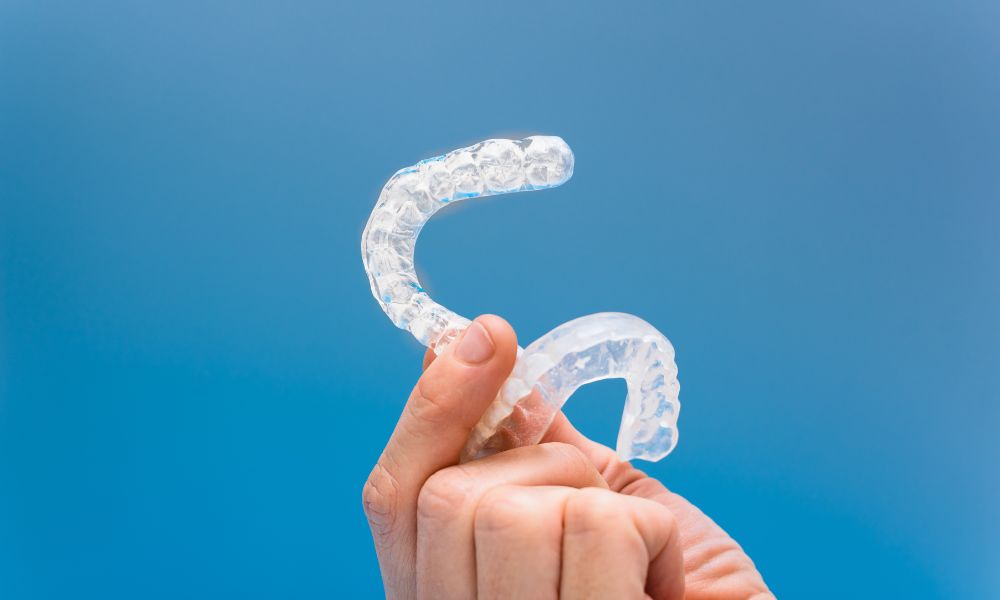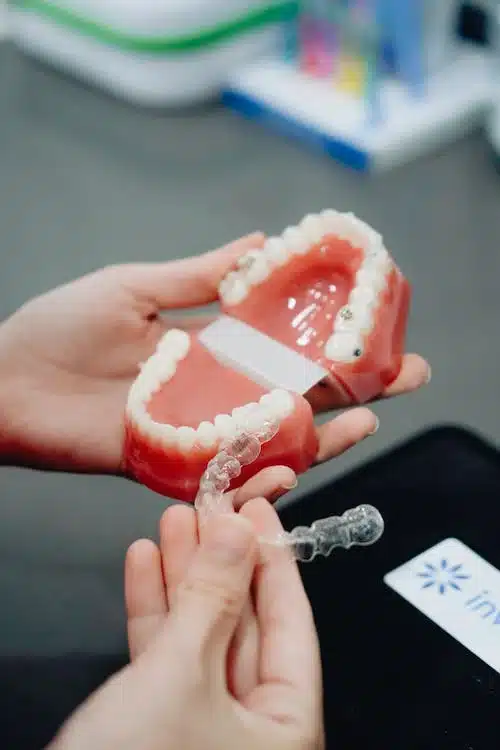Guide to TMJ Splints
A Guide to TMJ Splint: The Things You Need To Know
Do you experience stiffness, soreness, or sudden popping while moving your jaws? According to the National Institute of Health, almost 5-12% of Americans suffer from this sensation, two times more likely affecting young women. Wearing a TMJ splint can be one way to ease these symptoms.
While the pain is severe, it is not life-threatening but may cause immobility, thus affecting the quality of life. However, the sensation is not because of weak jaws but the temporomandibular joint that limits or hinders jaw movement.
And the common question of everyone, is TMJ curable? The good news is it is a treatable and curable condition that requires orthodontic care. But before we dive deeper into the treatment plans, let us first understand what a TMJ is, what TMD joint disorder is, its causes, and its symptoms.

In This Article:
- What Is TMJ (TemporoMandibular Joint)?
- What Is a TMJ Condition?
- Causes of TMD Joint Disorder
- 2 Most Effective Treatment Types For Your TMD Joint Disorder
- Quick Overview of Splint Therapy
- What is TMJ Splint Therapy?
- How Long Should You Keep Your TMJ Splint On?
- Benefits of a TMJ Splint
- Is TMJ Curable?
- How Much Does TMJ Splint Cost?
- The Bottom Line – Connect with Mint Dental MN
What Is TMJ (TemporoMandibular Joint)?
TMJ is the temporomandibular joint hinging our jaws at the front of our ears on both sides of the mouth. They extend from your mandible, your lower jaw, to the area around your temple. The joint gives freedom of movement to perform functions such as chewing and talking efficiently. Since it is the most active joint, it is prone to musculoskeletal pain, also called TMD joint disorder.
What Is a TMJ Condition?
You may have a TMJ condition if your jaw muscles hurt and it is difficult for you to speak or chew. Imagine it as having poor posture. Once you build up your muscles and start to sit up straight, incorrect posture can create back pain and shoulder aches that won’t go away.
Common Symptoms
When you have TMJ issues, your jaws may not be in proper alignment, which can result in uncomfortable symptoms that recur until you resolve the underlying problems, such as:
- Headaches
- Stiffness
- Jaw pain
- Ear pain
- Locked jaw
- Trouble chewing
Causes of TMD Joint Disorder
When one or both of your TMJs are strained or injured, it is known as having temporomandibular joint disorders (TMDs). These problems are a result of a variety of different things, and they frequently occur when your joints are repeatedly stressed, such as when:
- Stress in life
- Jaw injury
- Arthritis
- Clenching your jaw
- Teeth grinding (bruxism)
- Improper jaw alignment
2 Most Effective Treatment Types For Your TMD Joint Disorder
The VIVOS DNA device and splint therapy are efficient non-surgical methods for jaw pain. What, though, are these procedures, and how do they differ? By reading on, you learn more about these two treatments and how they can help your TMJ issues.
Quick Overview of Splint Therapy
Splint therapy is the cornerstone and an essential component of a complete TMJ treatment procedure. It is the main and most crucial treatment tool for many TMJ problems. Splints can treat temporomandibular issues, stabilize the bite, or protect the teeth from damage and wear. The treatment aims to restore jaw-muscle function and decrease related pain by establishing a balanced bite.
The marketing of bite plates and night guards for clenching, grinding (bruxism), TMJ, and facial pain is widespread. Additionally, many patients use over-the-counter night guards. The pain and clicking in the TMJ can indicate a more serious issue.
What is TMJ Splint Therapy?
The word “splint” may have already come up while discussing how to treat athletic injuries like a fractured wrist or twisted ankle. In dentistry, splint therapy refers to a type of TMJ condition dental treatment that uses a bite plate or mouth guard to assist with frequent symptoms brought on by occlusion. Splint therapy accomplishes this in many methods, such as:
- Relaxing the joints and muscles in your jaw to release tension in your mouth. It aids in the recovery of your mouth from the stress of jaw reflexes like clenching your teeth.
- Preventing additional bruxism, which wears down teeth, and involves teeth grinding. You can preserve and keep the majority of the natural teeth as you can as a result.
- Correcting an overbite or underbite by better aligning the jaw. It can help you breathe more easily while you’re at rest or while eating.
It might surprise you that something as straightforward as a mouthguard might help you feel better. These are not your typical mouthguards, either. They are dental devices explicitly designed to help your mouth’s health.
Two TMJ Splint Types
Stabilization and repositioning splints are two distinct types used by dentists, each with a specific purpose. One intends to hold your bite in place, while the other helps to position your jaw in the best possible way. Here are further details on the advantages of each variety for you.
Stabilization Splint
The best patients for stabilizing splint therapy frequently grind and clench their teeth. This mouthguard completely encloses the teeth, preventing tooth-to-tooth contact and maintaining the jaw’s current position. Most people wear mouthguards or stabilization splints when sleeping.
Repositioning Splint
Your jaw may shift from its optimal position due to bone development, accidents, tooth loss, and other circumstances. A repositioning splint should be constantly worn, except during meals, to treat the ensuing TMJ occlusion. The bite could shift back to its unbalanced alignment if the patients do not use the splint regularly.

Do TMJ Splints Work?
Yes. Splints gently shift your teeth and open your jaws for proper bite formation. As you close your mouth, your teeth shouldn’t come in contact, unlike your lips. Many of us, regrettably, clench our teeth too tight. A splint cushions your teeth and jawline so that your TMJ restores its natural alignment, mainly during resting state and when the joint isn’t fully engaged. As a result, it relaxes your bite muscle and those surrounding your neckline and shoulders.
However, there are several situations in which TMJ splints might not work. For example, biting or chewing your meal requires unusual joint movements due to significant tooth and jaw misalignment. When that’s the case, your TMJ has to overcompensate and move abnormally while you eat constantly. Usually, bite splints alone won’t be enough to resolve such situations. Instead, your TMD treatment may include orthodontic therapy as a crucial component.
What Is Splint Therapy For TMJ?
The initial line of defense against TMJ pain or TMD is splint therapy. The good news is that the first recommendations for treating TMJ problems include non-surgical treatments like biting splints. Warm compresses, a softer diet, and over-the-counter medication are further suggestions. The need for more harsh therapy only arises when symptoms are severe.
By spending money on a biting splint, you may treat TMD where it originates—in your jaws and mouth. Even though tooth enamel is incredibly dense and strong, tooth-on-tooth wear can permanently harm your teeth and any dental restorations already in place. You can still smile with a splint!
How Long Should You Keep Your TMJ Splint On?
Most people with bruxisms(grinding and clenching ) wear TMJ splints at night. It is because you might experience discomfort or TMJ symptoms such as headaches, dizziness, and limited mouth motions in the morning.
Wearing daytime bite splints as needed mitigates soreness in the jaws, especially when you’re under a lot of stress or pressure (such as missing deadlines of crucial projects). It also reduces clenching or grinding teeth and relieves pain.
You might need to wear it for a few weeks till your symptoms subside. While the National Institute of Health recommends using a TMJ splint for a short time, you may wear it more frequently if you experience flare-ups during emotional, physical, or mental distress. People with severe bruxism might need to get new sets of splints every year.
Benefits of a TMJ Splint
By enhancing jaw alignment, easing tension on the jaw muscles, and offering a padded surface between your teeth, a TMJ splint can assist in alleviating some of the problems contributing to joint dysfunction. Your mouth may need some time to adjust, but once it does, the following advantages will become apparent:
• Less clenching and grinding of the teeth due to the cushioning.
• Less pressure and stress in the muscles will lessen jaw soreness, earaches, and headaches from tension.
• Better jaw alignment leads to cleaner airways for better breathing.
• Prevents wear and tear of teeth
• A more appealing appearance due to balanced jaw position and even bite.
Is TMJ Curable?
Fortunately, TMJ (temporomandibular joint) disorder is not considered an irreversible condition. But a proper treatment and lifestyle changes, it is possible to cure TMJ pain permanently.
The primary causes of TMJ pain are teeth grinding and clenching, which put pressure on the joint. Therefore, stopping these habits is crucial for treating TMJ. Additionally, avoiding activities that exert pressure on the joint and adopting a soft diet can help alleviate symptoms and prevent further damage to the TMJ.
To help ease your jaw pain, here are 8 TMJ self-care exercises you can do at home.
How Much Does TMJ Splint Cost?
A TMJ splint is cost-effective compared to the care and time needed for pain management, surgery, and irreparable teeth damage. It reduces the chances of future unneeded treatment as a cheap layer of “insurance.” You can check on your health coverage before or during your consultation to see if your health insurance provider covers mouth splint treatment.
How Does VIVOS DNA Appliance Relieve Jaw Pain?
The VIVOS Day-Night Appliance (DNA) is a detachable oral appliance that resembles a retainer. It aims to fit your tooth form and bring your lower jaw into the proper position with your upper jaw. The DNA appliance can relieve uncomfortable symptoms when used as directed and will lessen the strain on your TMJ.
The VIVOS DNA appliance, in contrast to splint therapy, can promote forward jaw growth and widening of the hard palate. Daily actions like chewing and speaking place less strain on the joints when your jaw and TMJs are in normal alignment. It lessens the excruciating TMJ dysfunction symptoms. The device doesn’t just manage the symptoms; it also addresses the fundamental problem.
The Bottom Line – Connect with Mint Dental MN
Splint therapy is the foundation and a necessary component of a comprehensive TMJ Splint treatment. However, only a specialist dentist can create a customized TMJ splint to match your jaw shape. The “one-size-fits-all” design of over-the-counter bite splints is useless and may even exacerbate TMD symptoms.
Call your specialist immediately if you think you could be suffering from TMD symptoms and want to know if splints can help. Mint Dental MN provides TMJ appliance therapy and personalized mouth splints when necessary.
Our unique impression procedure ensures a secure and comfortable fit, allowing you to maximize the benefits of your dental splint. Contact us immediately to schedule a consultation if you are suffering from TMD.

